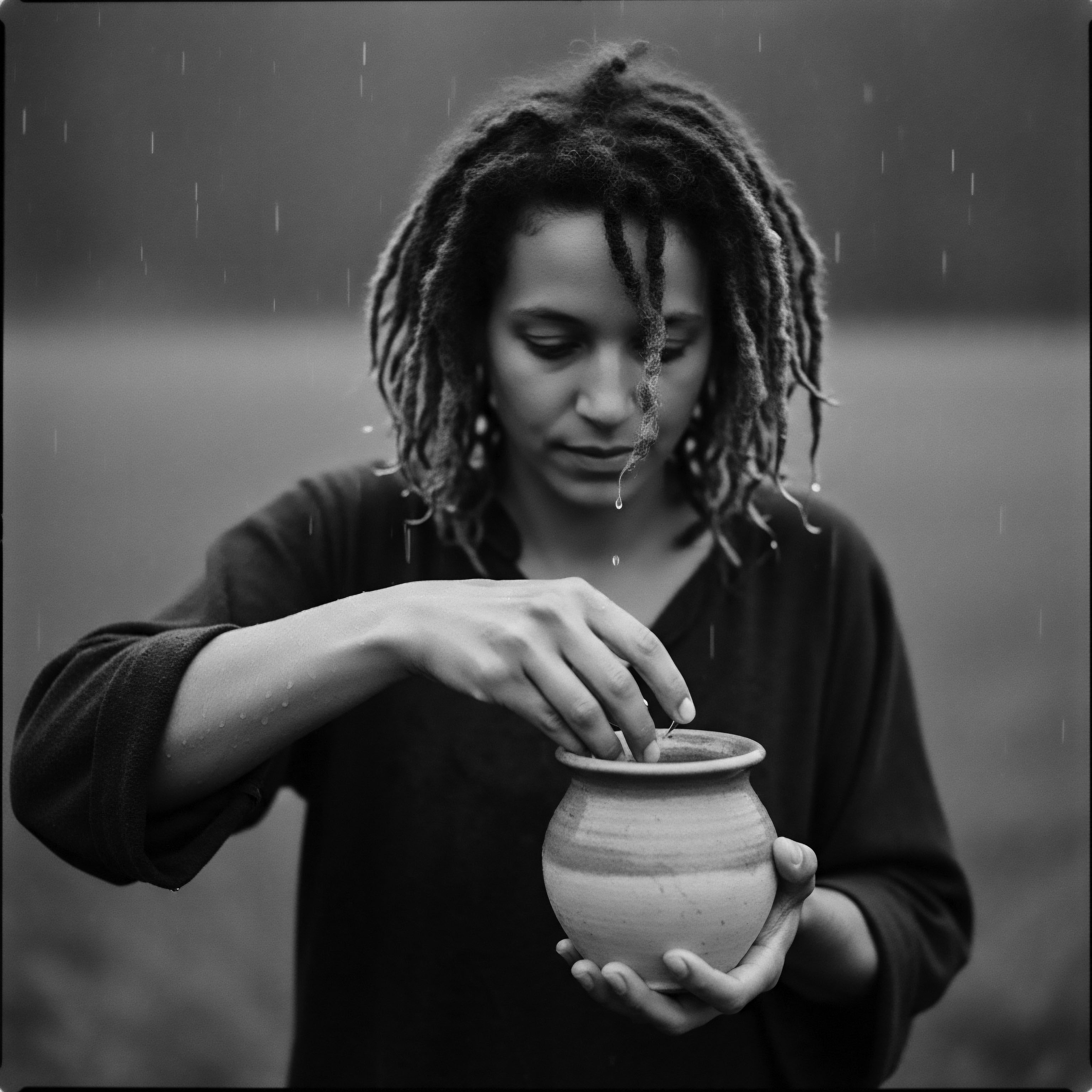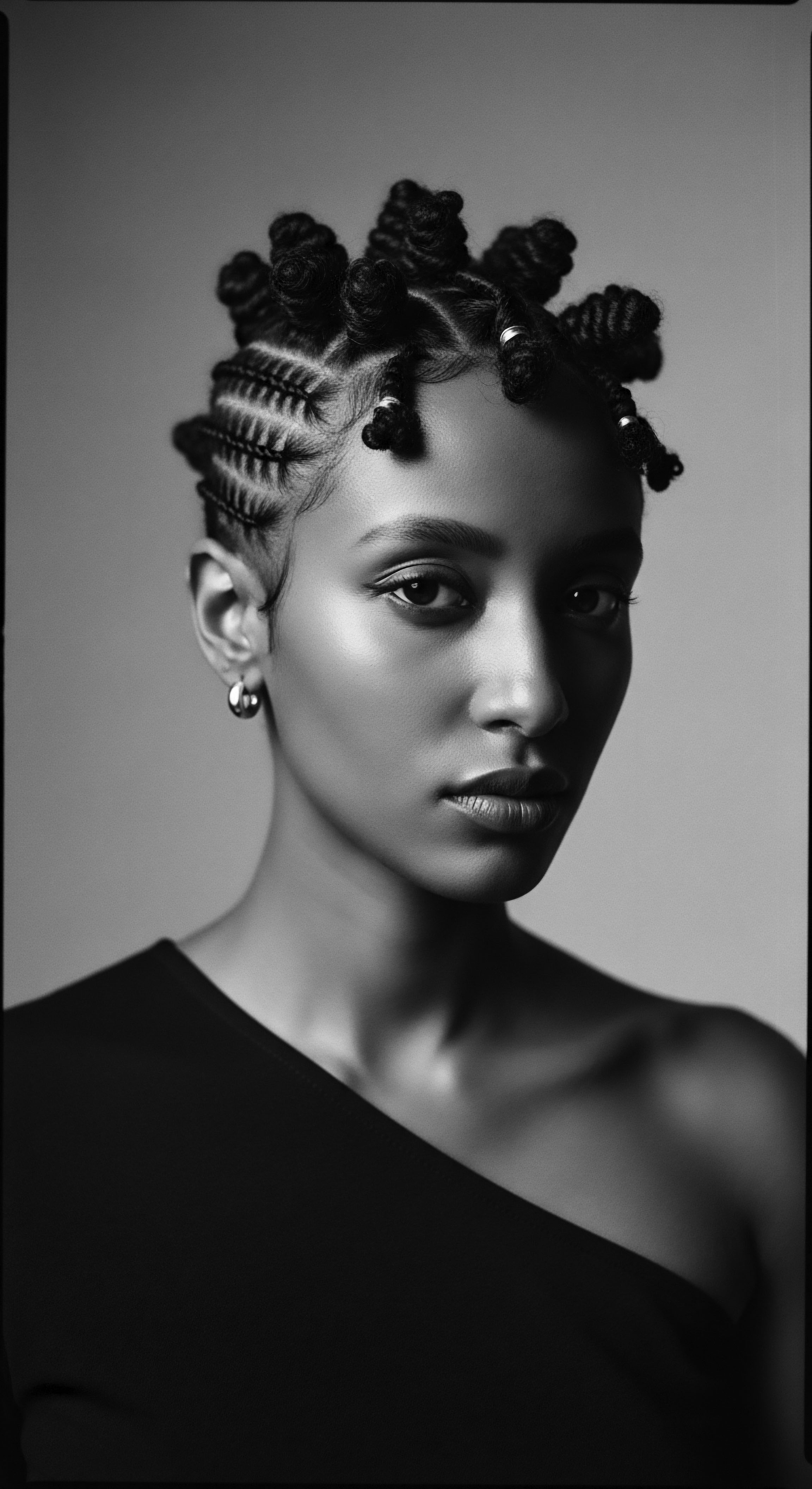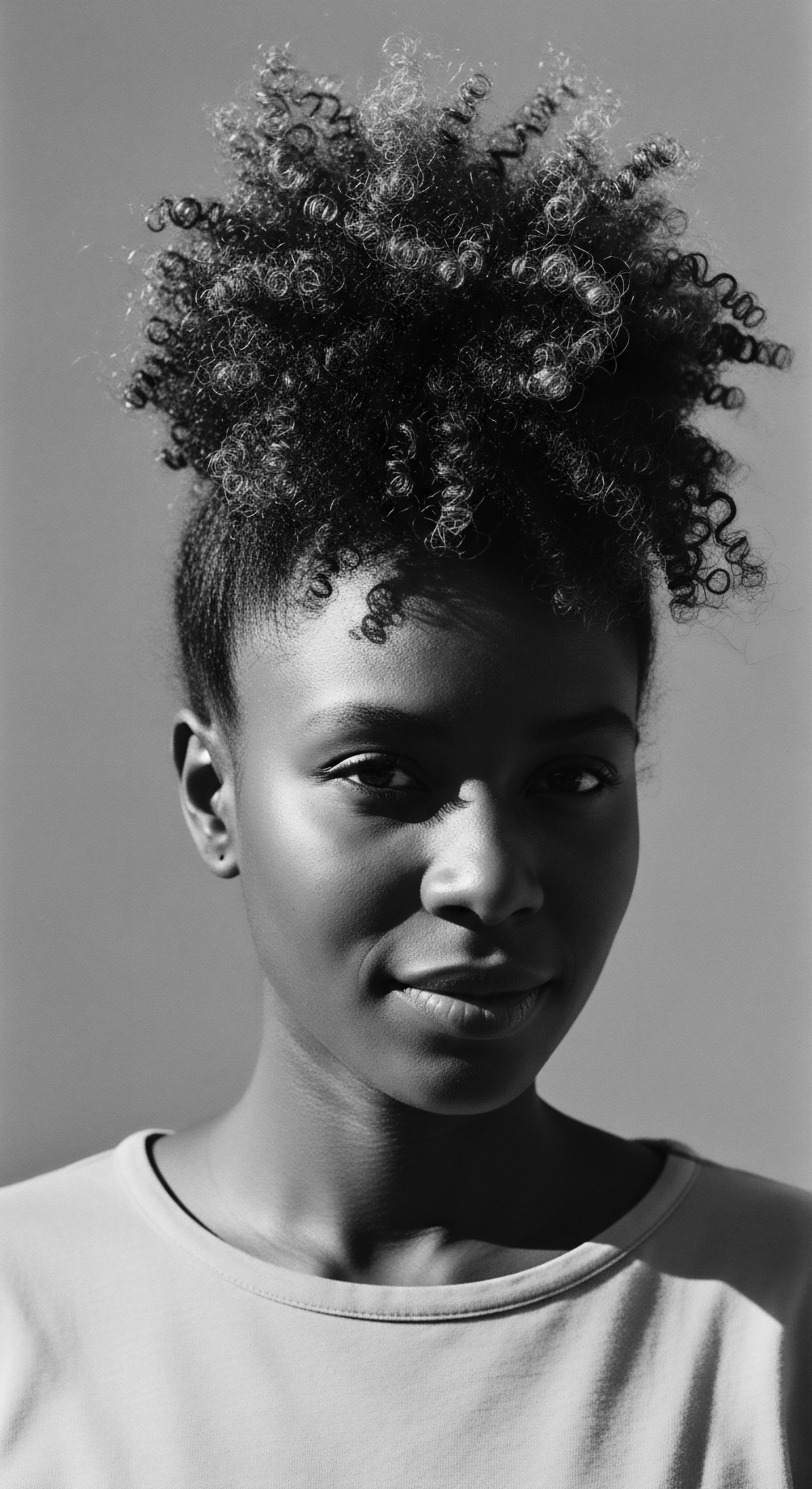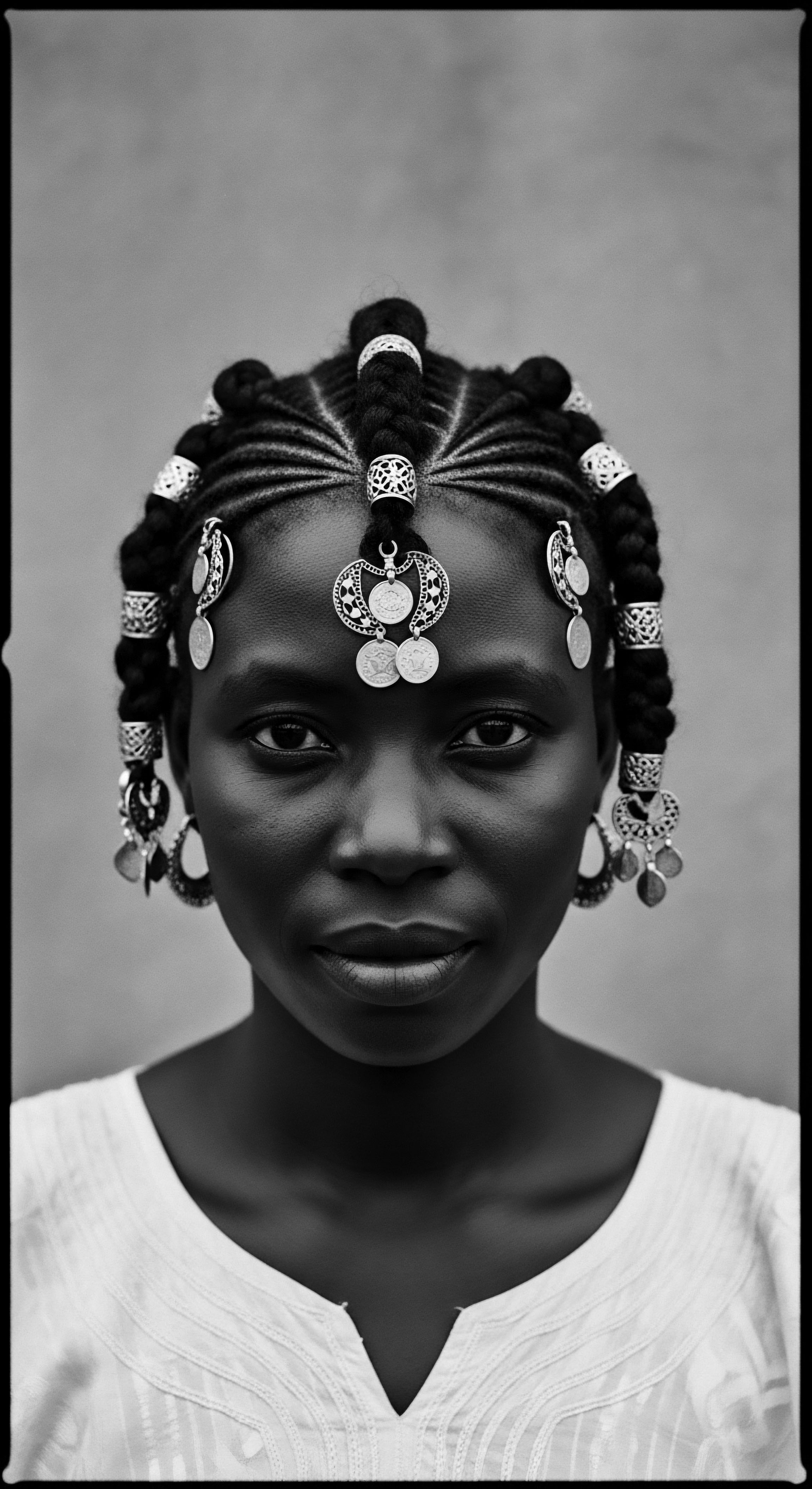
Fundamentals
Life Stage Rituals, in their fundamental meaning, refer to the profound ceremonies and practices communities enact to acknowledge and consecrate significant transitions in an individual’s existence. These are not merely celebrations; they stand as solemn acknowledgments of a shifting social identity, a movement from one state of being to another. From the very first breath drawn to the final exhale, human lives are marked by a series of passages—birth, the blossoming of youth, unions of partnership, the wisdom of elderhood, and the passage beyond earthly bounds. Each such juncture carries an inherent gravity, a need for communal recognition that transcends the purely biological.
Consider the simple, yet powerful, act of hair’s presence on the human head. For textured hair, particularly within Black and mixed-race communities, hair is more than a biological outgrowth. It serves as a living archive, a visible testament to lineage, cultural narratives, and ancestral practices.
The very strands, each coiling helix, carry echoes from the source, whispering stories of resilience and creation. When we speak of Life Stage Rituals through the lens of textured hair, we begin to explore how these personal and communal transitions are inextricably linked to hair care, styling, and its symbolic expressions.

The Language of Hair in Early Life
From the tenderest moments of infancy, hair begins its journey, often becoming the first canvas for these rites. A baby’s first haircut, for instance, might be a quiet, personal ceremony in some families, symbolizing a severing from the primordial past and an induction into a new phase of personhood. In other contexts, it could involve specific oils, prayers, or the collection of discarded strands, each gesture imbued with deep familial and spiritual significance. The nascent curls, coils, and waves receive their initial blessings, setting a trajectory for a lifetime of care, connection, and identity.
The earliest interactions with textured hair during these foundational moments establish patterns of nurturing that speak volumes about a family’s understanding of heritage. The tactile nature of combing, detangling, and styling a child’s hair becomes an intimate act of bonding, a transmission of wisdom through touch and quiet conversation. This foundational period often shapes a person’s lifelong relationship with their own hair, imprinting it with lessons of patience, self-acceptance, and cultural pride.

Community and the Crown
Hair has always held a sacred, social, and aesthetic significance for people of African descent across millennia. It acted as a communication system in West African societies during the 15th century, with hairstyles conveying messages about marital status, age, religion, wealth, and social rank. These visible markers, fashioned with intention and skill, became powerful identifiers of an individual’s place within the collective. The care given to each strand became a collective endeavor, often performed within communal gatherings where stories were shared, wisdom imparted, and bonds fortified.
This communal aspect of early hair care sets the stage for a deeper comprehension of how Life Stage Rituals are not solitary events, but rather shared experiences. They are moments where the individual’s journey is affirmed and supported by the broader community, linking each personal progression to the enduring traditions of their lineage. The very act of caring for textured hair, a practice passed down through generations, embodies this continuity, connecting current experiences to the ancient rhythms of care and kinship.
Life Stage Rituals are communal ceremonies that acknowledge and mark significant personal transitions, with textured hair often serving as a profound symbolic canvas for these shifts.

Intermediate
Moving beyond the foundational comprehension, an intermediate engagement with Life Stage Rituals reveals their intricate layering, especially when viewed through the lens of textured hair heritage. These rituals are not static declarations; they are dynamic processes, echoing the fluidity of human existence itself. They possess a profound spiritual meaning, serving as portals that usher individuals from one state of social being into another, fundamentally altering their perception of self and their position within the community.

The Sacred Geometry of Growth
Consider the adolescent years, a period of dramatic transformation. For individuals with textured hair, this growth often manifests in profound personal and communal ways. The choices made about hair during these years—whether to maintain natural forms, explore protective styles, or engage with various straightening methods—often reflect a budding identity, a dialogue between ancestral heritage and contemporary influence.
In many African cultures, the onset of puberty was celebrated with specific hair rituals, symbolizing a young person’s entry into adulthood and readiness for new responsibilities. The manipulation of hair, whether through new braiding patterns or ceremonial adornments, became a tangible expression of this elevated status.
- Puberty Hairstyles ❉ In numerous traditional African societies, particular hair designs were reserved for those reaching adolescence, signifying maturity and a readiness for marital consideration or community roles.
- First Braiding Ceremonies ❉ For young girls, learning the intricate art of braiding from elders often marked a rite of passage, transmitting not only skill but also oral history and cultural knowledge through touch and shared moments.
- Hair as a Map ❉ Specific patterns, lengths, or adornments could communicate a person’s readiness for marriage, their eligibility, or even their lineage, acting as a visual language within the community.
The act of styling textured hair for these intermediate life passages was often a communal endeavor, fostering deep bonds between individuals and across generations. It was a time for storytelling, for sharing wisdom, and for reinforcing the collective identity that flowed through the very strands of their hair. These shared moments of care, often stretching over hours, became sacred spaces where the continuity of cultural heritage was not just spoken but lived, felt, and braided into being.

Hair as a Symbol of Social Standing and Transition
The social significance of hair goes beyond aesthetics. It functioned as a powerful communicator of status, religion, and age within various African societies long before European encounters. The intricate styling of hair, which could take days, was not merely a stylistic choice; it was an act steeped in meaning, reflecting the wearer’s journey through life. When a woman adorned her hair with specific beads, cowrie shells, or changed its style following marriage or childbirth, these were visual announcements to her community, recognized and respected.
| Era/Context Ancient African Societies (e.g. Yoruba, Fulani) |
| Hair as a Marker Intricate braids, wraps, adornments |
| Reflected Life Stage/Status Marital status, age, wealth, tribal affiliation, spiritual connection |
| Era/Context Transatlantic Slave Trade & Enslavement |
| Hair as a Marker Shaved heads, hidden styles (e.g. cornrows for maps) |
| Reflected Life Stage/Status Loss of identity, forced assimilation, covert resistance, survival |
| Era/Context Post-Emancipation & Early 20th Century Diaspora |
| Hair as a Marker Hair straightening for societal acceptance |
| Reflected Life Stage/Status Assimilation into dominant beauty standards, pursuit of social mobility |
| Era/Context Civil Rights & Black Power Movements (1960s-70s) |
| Hair as a Marker Afro, natural styles |
| Reflected Life Stage/Status Reclamation of identity, political statement, self-acceptance |
| Era/Context Contemporary Era (Diaspora) |
| Hair as a Marker Diverse natural styles (locs, braids, coils), wigs, weaves |
| Reflected Life Stage/Status Personal expression, professional identity, cultural pride, ancestral reconnection |
| Era/Context Hair has consistently served as a powerful, evolving language of identity and belonging across the diasporic journey. |
The legacy of these practices carried across the Middle Passage, though transformed by the brutal realities of enslavement. While enslavers attempted to strip away identity by shaving heads, the resilience of African people ensured that hair continued to hold hidden meanings. Cornrows, for instance, were sometimes used to store seeds or even create maps for escape, turning a beauty practice into a tool of survival and defiance.
This adaptation demonstrates the enduring power of hair as a repository of cultural knowledge and a silent witness to history, even under duress. The continuity of these ancestral practices, even in modified forms, underscores the deep-seated cultural significance of hair beyond mere appearance.
The journey through Life Stage Rituals for textured hair illuminates how hair serves as a living chronicle of identity, community, and ancestral resilience.

Academic
The academic understanding of Life Stage Rituals, often framed within the anthropological concept of ‘rites of passage’ as theorized by Arnold van Gennep and later elaborated by Victor Turner, offers a robust framework for dissecting the profound socio-cultural mechanics at play. Van Gennep’s seminal work, “Les Rites de Passage,” published in 1909, delineated a tripartite structure for these rituals ❉ Separation (pre-liminal rites), Transition (liminal rites), and Incorporation (post-liminal rites). Within this scholarly paradigm, the explicit and implicit roles of textured hair within Black and mixed-race communities become particularly salient, extending beyond mere aesthetics to the very core of identity, social stratification, spiritual connection, and the maintenance of communal cohesion across generations.
The initial phase, Separation, involves a symbolic or actual withdrawal of the individual from their previous status. This detachment from a former self is often manifested through physical alterations, including changes to hair. For instance, individuals joining the military frequently have their hair cut short, signifying a deliberate shedding of civilian identity.
In some traditional African contexts, specific hairstyles were abandoned or hair was even shaved as a preliminary step in initiation rites, preparing the individual for a profound re-orientation of their being. This ritualistic divestment of prior identity, frequently enacted upon the hair, sets the stage for the transformative journey ahead.

The Liminality of Strands ❉ Between Worlds
The Liminal phase, a threshold period, represents a state of ambiguity where the individual exists between worlds—no longer holding their old status, yet not fully integrated into their new one. This interstitial state is often marked by symbolic vulnerability or instruction. For textured hair, this might manifest in the deliberate cultivation of specific styles that are atypical of everyday wear, or even a period of minimal styling, reflecting a state of being in flux.
The hair, during this liminal period, ceases to be a marker of established identity and instead becomes a canvas for the unknown, a silent participant in the spiritual and social metamorphosis. The inherent ambiguity of liminality aligns with the fluidity and adaptability that textured hair has historically displayed, constantly adapting to circumstances, societal pressures, and the deep wellspring of cultural ingenuity.
Finally, Incorporation marks the successful completion of the ritual, with the individual re-entering society endowed with a new status and a reformulated identity. The hair, too, reflects this new state, often adorned in styles that clearly articulate the individual’s new role, responsibilities, or privileges. This could involve the donning of an elaborate headdress, the adoption of a specific braided pattern signaling marital status, or the growth of hair into a form that embodies newfound wisdom or spiritual commitment.

Hair as a Socio-Spiritual Cadaster ❉ A Case Study from the African Diaspora
To deeply grasp the intersection of Life Stage Rituals and textured hair heritage, one must examine concrete historical instances where hair explicitly articulated identity and social transition. Consider the profound socio-cultural significance of Hair within the Enslaved African and African American Communities. While colonial powers and enslavers often sought to strip away the cultural markers of African identity through practices such as forced head shaving, hair remained a powerful, albeit often covert, medium for resistance, communication, and the perpetuation of heritage. This period represents a stark example of life stage rituals being violently disrupted, yet their underlying meaning stubbornly endured through the very practices that survived.
For instance, the intricate art of Cornrowing, a technique brought from various West African societies, served multiple functions beyond simple adornment. During enslavement, this practice took on new, critical meanings. Cornrows were not only a means of maintaining hygiene and managing hair under harsh conditions, but they also became a clandestine method of communication and cartography. Enslaved individuals would sometimes braid patterns into their hair that visually represented escape routes, contained seeds for survival, or signaled intentions to fellow captives.
These “maps” or “messages” were not explicitly “Life Stage Rituals” in the traditional sense of marking a specific transition from childhood to adulthood or maidenhood to marriage. Instead, they transformed the very act of hair styling into a ritual of survival, a desperate, yet profound, passage from captivity towards freedom, or at least the hope of it. This practice, often conducted in hushed tones, became a silent but potent collective ritual, marking a transition from passive endurance to active resistance within the brutal confines of their existence. The very act of a mother braiding her child’s hair in a specific pattern, containing hidden knowledge, was a life-saving initiation into the realities of their world, a ritual of resilience.
Moreover, the communal act of hair grooming persisted, often becoming a sacred space where stories, traditions, and ancestral wisdom were whispered and passed down through generations. These moments of shared care, despite the crushing weight of oppression, became de facto “rituals” that underscored the continuity of community and identity amidst systemic efforts to dismantle it. A statistic from a contemporary study highlights the enduring significance of hair in Black identity ❉ Research indicates that for Black women and girls, identity is inextricably linked to their relationship to and presentation of their hair, with hair often being perceived as “their crown and glory”.
This sentiment echoes the ancestral reverence for hair as a source of spiritual power and connection to the divine, a belief deeply rooted in ancient African societies. The enduring impact of these historical experiences means that for many Black women today, the choice to wear natural hair is itself a statement of self-acceptance and a reclamation of ancestral heritage, often involving a personal “rite of passage” away from Eurocentric beauty standards.
| Life Stage/Context Birth & Childhood |
| Traditional African Practices Initial head shavings, specific protective styles for infants, communal naming ceremonies involving hair. |
| Diasporic Adaptations/Transformations First haircuts often hold special meaning; early braiding sessions as bonding rituals and cultural instruction. |
| Life Stage/Context Adolescence & Coming of Age |
| Traditional African Practices Elaborate hairstyles marking puberty and eligibility for marriage, specific braiding patterns signifying new social roles. |
| Diasporic Adaptations/Transformations Embracing natural texture (e.g. the Afro in the Civil Rights era) as a statement of self-affirmation and collective identity. |
| Life Stage/Context Marriage & Adulthood |
| Traditional African Practices Complex bridal coiffures, styles indicating marital status or number of children, adorned with culturally specific embellishments. |
| Diasporic Adaptations/Transformations Weddings incorporating traditional African hair adornments; loc journeys signifying commitment, wisdom, and spiritual growth. |
| Life Stage/Context Mourning & Loss |
| Traditional African Practices Shaving hair as a sign of grief or rebirth, specific mourning styles, leaving hair unkempt as a sign of ritual uncleanliness. |
| Diasporic Adaptations/Transformations Cutting hair in solidarity with collective mourning; periods of unstyled hair during bereavement. |
| Life Stage/Context Eldership & Ancestorship |
| Traditional African Practices Longer, more elaborate styles signifying wisdom and respected status, hair as a conduit to ancestors. |
| Diasporic Adaptations/Transformations Maintaining locs or crowns of natural hair as a symbol of lived experience, spiritual connection, and ancestral reverence. |
| Life Stage/Context Across epochs and geographies, textured hair has served as a dynamic, symbolic conduit for marking and navigating human transitions. |

Beyond the Visible ❉ The Psychological & Sociological Dimensions
The academic lens also considers the psychological impact of these rituals. The process of separation, liminality, and incorporation, when enacted through hair practices, profoundly shapes an individual’s self-concept and collective identity. For individuals within the African diaspora, the journey of their hair, whether it involves the maintenance of intricate natural styles, the decision to loc, or the daily ritual of conditioning and detangling, is often intertwined with a deeper psychological exploration of self-acceptance and cultural pride.
This is especially pertinent given the historical pressures to conform to Eurocentric beauty standards, which frequently necessitated the chemical or thermal alteration of textured hair. Scholars have noted that for Black women, hair is emotive and inextricably linked to their identity, with decisions about hair directly impacting their sense of self and well-being.
Sociologically, Life Stage Rituals involving hair reinforce social structures and group solidarity. The shared experiences of braiding sessions, the intergenerational transmission of care techniques, and the communal celebration of hair milestones strengthen social bonds. These practices create a sense of belonging, a collective memory that transcends individual lifetimes.
They serve as conduits for cultural transmission, ensuring that the rich heritage of textured hair care and its associated meanings continue to flow through the veins of future generations. The very act of caring for one’s textured hair, a practice passed down through generations, is a living ritual, a tangible connection to those who came before, fostering a profound sense of lineage and continuity.
The resilience inherent in textured hair, its coiled and unique forms, mirrors the resilience of the communities who carry its legacy. The ability of hair to be braided, twisted, loc’d, or left free provides a visual language of adaptation and endurance. Understanding Life Stage Rituals through this specific cultural lens means acknowledging not just the external markers of transition, but the deep internal shifts, the whispers of history carried in each strand, and the enduring power of hair to connect past, present, and future generations. The intricate care required for textured hair often becomes a daily ritual in itself, a quiet meditation on lineage and self-worth, extending the concept of ‘life stage’ to encompass the ongoing journey of self-discovery and affirmation.
Academic inquiry reveals Life Stage Rituals as a three-phase process of separation, transition, and incorporation, with textured hair practices often serving as critical physical and symbolic markers of these profound societal and individual shifts.

Reflection on the Heritage of Life Stage Rituals
The journey through Life Stage Rituals, viewed through the intricate lens of textured hair heritage, is a profound meditation on the enduring echoes from the source. It underscores how hair, a seemingly simple biological extension, transforms into a powerful repository of ancestral wisdom, communal memory, and individual identity. From the tender touch of a grandmother’s hands braiding a child’s hair, passing down not just skill but also stories and songs, to the defiant beauty of a natural crown embraced amidst societal pressures, each moment is a testament to an unbroken lineage of care and meaning. The tender thread of connection woven through these rituals reminds us that our personal hair journeys are deeply intertwined with the collective experience of our forebears.
The very act of nurturing textured hair, whether through the meticulous creation of a protective style or the thoughtful application of ancestral oils, transcends mere grooming. It becomes a sacred practice, a dialogue with those who came before, a reaffirmation of self within a rich historical context. These rituals, sometimes grand and communal, other times quiet and personal, are not relics of a bygone era. They continue to shape futures, providing grounding in a rapidly changing world.
The unbound helix of our hair, free to coil and express its inherent design, symbolizes the liberation found in embracing one’s authentic heritage, a powerful statement of self-acceptance and cultural pride. This deep connection ensures that the wisdom embedded in every strand continues to guide and inspire, carrying forward the profound legacy of textured hair as a living, breathing archive of identity and resilience.

References
- Byrd, Ayana D. & Tharps, Lori L. (2001). Hair Story ❉ Untangling the Roots of Black Hair in America. St. Martin’s Griffin.
- Johnson, T. A. & Bankhead, T. (2014). Hair It Is ❉ Examining the Experiences of Black Women with Natural Hair. Open Journal of Social Sciences, 2(1), 86-100.
- Garrin, A. & Marcketti, S. B. (2018). The Impact of Hair on African American Women’s Collective Identity Formation. Clothing and Textiles Research Journal, 36(2), 104-118.
- Rowe, Kernysha L. (2023). Black Hair and Hair Texture ❉ Cultivating Diversity and Inclusion for Black Women in Higher Education. Leadership in Turbulent Times, 121-139. Emerald Publishing Limited.
- Van Gennep, Arnold. (1960). The Rites of Passage. University of Chicago Press. (Originally published in French in 1909).
- Ampim, Manu. (2020). Rite of Passage – Social Sci LibreTexts. Social Sci LibreTexts.
- Matjila, Chéri R. (2020). The meaning of hair for Southern African Black women. University of the Free State.
- The History and Cultural Significance of African Hair Braiding. (2023). Elom African Braids.
- A Crowning Glory ❉ Hair as History, Identity, and Ritual. (2024). Khumbula.
- Women in Beauty Cultures and Aesthetic Rituals in Africa. (2023). Oxford Research Encyclopedia of African History.
- Rite of passage ❉ An African indigenous knowledge perspective. (2017). NCBI.
